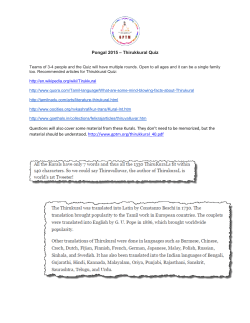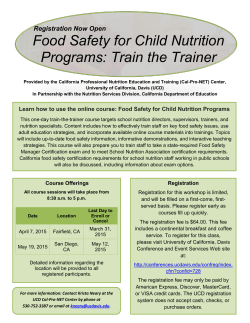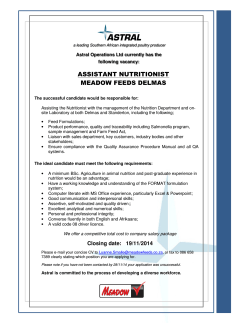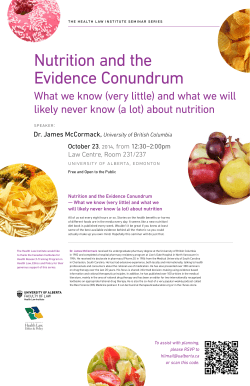
FNH 471: Human Nutrition over the Lifespan
The University of British Columbia Faculty of Land and Food Systems Food, Nutrition and Health FNH 471: Human Nutrition over the Lifespan January ʹ April 2015 INSTRUCTOR: Dr. Candice Rideout OFFICE: FNH 249, 2205 East Mall PHONE: 604-‐822-‐0147 EMAIL: candice.rideout@ubc.ca Twitter: @carideout (course hashtag #FNH471) CLASS TIME and LOCATION: Tuesdays & Thursdays 11:00 AM to 12:30 PM in West Mall Swing Space (2175 West Mall) OFFICE HOURS: Thursdays from 1:00 PM to 3:00 PM (or by appointment) in FNH 249 COURSE DESCRIPTION: Nutritional requirements and dietary patterns of healthy individuals throughout the life span. LEARNING OUTCOMES: When you finish this course, you should be able to: 1. 2. 3. 4. 5. Describe physiological and psychosocial changes over the life span with implications for nutrition and indicate how nutritional needs and eating behaviours are affected by such changes. Assess dietary intakes of individuals at different life stages and comment on whether they conform to the guidelines presented in ĂŶĂĚĂ͛Ɛ&ŽŽĚ'ƵŝĚĞƚŽ,ĞĂůƚŚLJĂƚŝŶŐ͘ Plan nutritional intakes and provide appropriate advice on nutritional issues of concern for healthy individuals at different life stages. For major nutrients, describe how and why the requirement changes over the life span. Think critically about issues related to nutrition across the lifespan and evaluate sources of nutrition information. COURSE NOTES: There is no required textbook for FNH 471. Course notes are available for purchase at Copiesmart in the UBC village (#103-‐5278 University Blvd). ADDITIONAL RESOURCES: Additional resources include the items listed below and other items available in Connect. x ĂƚŝŶŐtĞůůǁŝƚŚĂŶĂĚĂ͛Ɛ&ŽŽĚ'ƵŝĚe, available here: bit.ly/19AzDU2 (hard copies will be distributed) x Health Canada, Canadian Paediatric Society, Dietitians of Canada, & Breastfeeding Committee for Canada (2012) Nutrition for Healthy Term Infants: Recommendations from Birth to Six Months. Available here: bit.ly/1chqN0v x Health Canada, Canadian Paediatric Society, Dietitians of Canada, & Breastfeeding Committee for Canada (2014) Nutrition for Healthy Term Infants: Recommendations from Six to 24 months. Available here: bit.ly/1xcVoIj x Canadian Guidelines for Body Weight Classification in Adults (Health Canada, 2003). Available here: bit.ly/19xvGVy and bit.ly/13FFsm2 CLICKERS: Students are required to have an iClicker ĨŽƌƚŚŝƐĐůĂƐƐ͘WůĞĂƐĞĐůŝĐŬŽŶƚŚĞ͞ZĞŐŝƐƚĞƌLJŽƵƌĐůŝĐŬĞƌŚĞƌĞ͟ůŝŶŬŽŶ the course website in Connect to register your clicker, if you have not registered your clicker in Connect previously. CLASS FORMAT: We will use a combination of lectures, large-‐ and small-‐group discussions, videos, clicker questions, small-‐group learning activities, and independent reflection and writing throughout this course. EVALUATION: Date In-‐class activities: Mini-‐assignments Clicker responses Online Quizzes: ηϭ͗>ŝĨĞ͛Ɛ'ƌĞĂƚĞƐƚDŝƌĂĐůĞ #2: ĂŶĂĚĂ͛Ɛ&ŽŽĚ'ƵŝĚĞ #3: How to Live to 101 Case Studies: #1: Childhood Case Study #2: Family Case Study Assignment: Lifespan Nutrition Q & A Midterm Final exam (cumulative) Throughout the term Throughout the term 9 AM Jan 16 ʹ 11:59 PM Jan 17 9 AM Jan 23 ʹ 11:59 PM Jan 24 9 AM Apr 3 ʹ 11:59 PM Apr 4 9 AM Mar 6 ʹ 11:59 PM Mar 7 9 AM Mar 27 ʹ 11:59 PM Mar 28 March 13 February 12 TBD (April 14ʹ 29) Proposed Value (% of Final Grade) 5 2.5 2.5 5 1 3 1 10 5 5 10 25 45 OR: Choose the value for you (% of Final Grade)* 5 2.5 2.5 5 1 3 1 5 ʹ 20 (50% of value) (50% of value) 0 ʹ 20 10 ʹ 30 30 ʹ 60 *If desired, you may determine the value each item will contribute to your final grade. Make sure that the values you choose are selected from within the ranges provided in blue for each item, and that the values add up to a total of 100%. Submit your decision to me by email at candice.rideout@ubc.ca by 11:59 PM on Thursday, January 15. No changes will be permitted after that date. If you wish to have your final grade calculated using the proposed value of each item, no email is required to confirm this ʹ the proposed values will be used for all students who have not specified otherwise. In-‐class activities ʹ mini-‐assignments: Individual and small group activities and mini-‐assignments will take place in class throughout the term. These must be completed and submitted in the class during which they were assigned. Late submissions will not be accepted. If you satisfactorily complete 90% or more of these, you will receive all 2.5 marks. If you complete and submit fewer than 90%, your mark will be calculated based on the proportion you completed (e.g., if you satisfactorily completed 80% of these, you would receive 2 out of 2.5). In-‐class activities ʹ clicker responses: Many classes will include clicker questions as one way to help you be active with your learning during class. Register your clicker in Connect (if you have not already done so) and bring it to class with you each day. If you respond to all the clicker questions on a particular day, you will receive one point for that day. If you earn 90% or more of the possible points available for clicker participation throughout the term, you will receive all 2.5 marks. If you receive less than 90% of the possible points, your mark will be calculated based on the proportion of points received (e.g., if you responded to all clicker questions in 70% of classes, you would receive 1.75 out of 2.5). Online quizzes: Quizzes require advance preparation and study (quizzes 1 and 3 are based on video documentaries, quiz 2 is based on ĂŶĂĚĂ͛Ɛ&ŽŽĚ'ƵŝĚĞ and the Resource for Educators and Communicators). You will have one hour to complete each quiz online through the course website in Connect. Quizzes will contain both closed-‐ended questions (e.g., multiple choice, true/false) and open-‐ended questions (e.g., short-‐answer questions). Online quizzes must be completed independently, and you must agree not to disclose the contents of the quiz to other students. Case Studies: Information for each case study is provided in your course notes. You are required to review and analyze the information and apply what you are learning in order to answer the questions included in the course notes before starting the online quiz for that case study (online quizzes are available in Connect; note deadlines above). You will have one hour to complete each case study quiz in Connect. Quizzes will include both closed-‐ended and open-‐ended questions based upon your analysis of the case study (and the questions included in your notes). These quizzes must be completed independently, and you must agree not to disclose the contents of the quiz to other students. Assignment: The assignment provides an opportunity to cultivate your curiosity and address your specific learning interests. You will be prompted to identify questions you have related to nutrition at various stages of life, select one of your questions, and provide a clear and concise evidence-‐based answer to that question (using at least two appropriate papers selected from the peer-‐reviewed literature). Refer to the complete assignment instructions posted in Connect. Midterm: You will have 80 minutes to complete the midterm. It will include multiple choice questions, true/false questions, matching questions, and short answer questions. Final exam: The date for the final examination will ďĞƐĐŚĞĚƵůĞĚďLJƚŚĞZĞŐŝƐƚƌĂƌ͛ƐKĨĨŝĐĞůĂƚĞƌŝŶƚŚĞƚĞƌŵ͘ You will have a maximum of three hours to complete the exam. It will include multiple choice questions, true/false questions, matching questions, short answer questions, and questions based on new case studies. COURSE OUTLINE: Date Topic Jan 6 Introduction: Course overview, hopes and expectations, preparation for effective learning Jan 8 ʹ 20 Nutrition during Pregnancy Fetal development, the placenta, maternal physiological changes during pregnancy, nutrient requirements during pregnancy, nutritional issues during the prenatal period Note: Online Quiz #1 (>ŝĨĞ͛Ɛ'ƌĞĂƚĞƐƚDŝƌĂĐůĞ) available 9 AM Jan 16 to 11:59 PM Jan 17 Jan 22 ʹ 29 Lactation Breast milk (composition, properties, etc.), physiology of lactation, maternal nutrient requirements during lactation, nutritional issues during lactation Note: Online Quiz #2 (ĂŶĂĚĂ͛Ɛ&ŽŽĚ'ƵŝĚĞͿĂǀĂŝůĂďůĞϵDJan 23 to 11:59 PM Jan 24 Feb 3 ʹ 10 Infant Feeding Physiological development and maturation of the infant, formula feeding, Dietary Reference Intakes, patterns of intake, nutritional issues during infancy Feb 12 Midterm examination Feb 16 ʹ 20 Reading Week: No Classes Feb 24 ʹ Mar 3 Childhood Nutrition Physiological changes, Dietary Reference Intakes, patterns of intake, nutritional issues during childhood Mar 5 ʹ 12 Adolescent Nutrition Physiological changes, Dietary Reference Intakes, patterns of intake, nutritional issues during adolescence Note: Case Study Quiz #1 (Childhood) available from 9 AM Mar 6 to 11:59 PM Mar 7 Note: Assignment due by 11:59 PM Mar 13 Mar 17 ʹ 26 Adult Nutrition Physiological changes, Dietary Reference Intakes, patterns of intake, nutritional issues during adulthood Note: Case Study Quiz #2 (Family) available from 9 AM Mar 27 to 11:59 PM Mar 28 Mar 31 ʹ Apr 7 Nutrition and Aging Physiological changes, Dietary Reference Intakes, patterns of intake, nutrition issues associated with aging Note: Online Quiz #3 (How to Live to 101) available 9 AM Apr 3 to 11:59 PM Apr 4 Apr 9 Course Review and Synthesis; Preparation for the Final Exam TBA (Apr 14ʹ29) Final Examination MY EXPECTATIONS OF STUDENTS IN FNH 471: 1. Attend all classes! If you must miss a class due to illness or other emergency, it is your responsibility to obtain notes for that day from a classmate. 2. Actively participate in the various learning activities in class ʹ this will greatly enhance your learning (and thereby reduce the amount of time needed for additional review prior to the midterm and final exam!). 3. Respect and make a positive contribution to our learning environment in class. Please arrive on time, turn your cell phone off, and if you bring a laptop, use it only for taking notes. Do not try to multitask in class! Not only will your own learning be significantly reduced, research has shown that students doing non-‐class activities on electronic devices distract other students, thereby compromising the learning of those other students as well (e.g., Sana, Weston & Cepeda, 2013; read the study here: http://bit.ly/Klj5JL). 4. Use the slides provided on Connect as a framework for your note-‐taking during class. Build on the material they contain ʹ and integrate material from the course notes ʹ to create an effective study and reference tool. 5. Take advantage of office hour time (Thursdays from 1:00 PM to 3:00 PM in FNH 249) to ask questions, seek clarification, or discuss issues further. 6. Provide feedback on the course. You will have two formal opportunities to do this: a midterm course evaluation (the results of which can be applied to the remainder of the course) and the official UBC course evaluation at the end of the semester. Please complete these evaluations! Your feedback and suggestions are greatly valued. 7. Enjoy this learning experience! ACADEMIC INTEGRITY: Academic honesty is a core value of scholarship. Students are reminded of the importance of academic integrity (more information available here: http://bit.ly/16MRoQe) and of ƚŚĞhŶŝǀĞƌƐŝƚLJ͛ƐƌĞŐƵůĂƚŝŽŶs regarding academic misconduct and plagiarism, including disciplinary measures (excerpted below and available here: http://bit.ly/1cbGHJ2 and here: http://bit.ly/18h6VG3) Ignorance of the appropriate standard of academic honesty is no defense to an allegation of Academic Misconduct. Academic Misconduct that is subject to penalty includes, but is not limited to, the following: 1. Plagiarism. Plagiarism occurs where an individual submits or presents the work of another person as his or her own. Scholarship quite properly rests upon examining and referring to the thoughts and writings of others. However, when excerpts are used in paragraphs or essays, the author must be acknowledged in the text, through footnotes, in endnotes, or in other accepted forms of academic citation. Plagiarism extends from where there is no recognition given to the author for phrases, sentences, or ideas of the author incorporated in an essay to where an entire essay is copied from an author, or composed by another person, and presented as original work. Students must ensure that when they seek assistance from a tutor or anyone else that the work they submit is actually their own. Where collaborative work is permitted by the instructor, students must ensure that ƚŚĞLJĐŽŵƉůLJǁŝƚŚƚŚĞŝŶƐƚƌƵĐƚŽƌ͛ƐƌĞƋƵŝƌĞŵĞŶƚƐĨŽƌƐƵĐŚĐŽůůaboration. Students are responsible for ensuring that any work submitted does not constitute plagiarism. Students who are in any doubt as to what constitutes plagiarism should consult their instructor before handing in any assignments. 2. Cheating. Cheating includes, but is not limited to: falsifying any material subject to academic evaluation; having in an examination any materials other than those permitted by the examiner; and using unauthorized means to complete an examination (e.g. receiving unauthorized assistance from a fellow student). 3. Submitting the same, or substantially the same, essay, presentation, or assignment more than once (whether the earlier submission was at this or another institution), unless prior approval has been obtained from the instructor(s) to whom the assignment is to be submitted. In other words... Be sure to do your own work! Discuss course work with friends and learn with and from each other as you complete in-‐class activities and assignments. But make sure you complete all quizzes and exams independently, without the use of aids that have not been authorized by the instructor. If you choose to do the assignment, you must write the report independently and make sure that you are properly attributing and citing sources. Please review resources available through the UBC Library and/or speak to me if you are unsure of how to do this. Photo credits: Left: LB1860 (CC-‐BY), Right: Steve Spinks (CC-‐BY-‐SA)
© Copyright 2025











